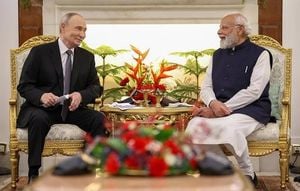As world leaders gather in New York for the United Nations General Assembly, the global struggle to address the climate crisis has reached a pivotal moment. A decade after the landmark Paris climate agreement was signed, the international community stands at a crossroads. The Paris accord, which once seemed a bold experiment, has undeniably accelerated the adoption of renewable energy and fostered international cooperation. Yet, the road ahead is fraught with new challenges, from geopolitical tensions and economic strain to the disruptive rise of artificial intelligence (AI) and the stubborn persistence of fossil-fuel interests.
Jennifer Morgan, former executive director of Greenpeace International and Germany’s state secretary for climate policy, reflected on the journey since Paris, noting, according to Project Syndicate, “The Paris agreement is one that all countries – whether fossil-fuel producers, island states, or the world’s wealthiest economies – negotiated and ratified in record time. It combines effective measurement and monitoring with flexibility for countries to determine and devise their own plans to confront climate change. Every five years, all governments are asked to do more. So far, and to the surprise of many, the vast majority of governments have actually done that.”
The numbers back up this optimism. In 2024, renewables accounted for a staggering 92.5% of all new installed electricity capacity worldwide, and 75% of new wind and solar photovoltaic projects now deliver cheaper power than existing coal, gas, and oil. The clean energy transition is happening under a wide spectrum of political systems and economic models, dispelling the myth that climate action is an ideological battlefield. As Morgan put it, “Countries are embracing renewables because they work: clean energy drives growth, enhances competitiveness, reduces energy price volatility, and improves quality of life.”
However, the world is not yet on track to meet the Paris targets. The effects of global warming—raging wildfires, devastating droughts, and catastrophic floods—are appearing faster and more intensely than many experts anticipated. The urgency is clear, but so is the progress made since 2015. As Morgan observed, “The undeniable progress since 2015 provides reason to hope that more progress can be made.”
This week’s UN General Assembly marks a critical test for the Paris agreement. All countries are expected to present their updated national climate plans, known as nationally determined contributions (NDCs), a process culminating in Belém, Brazil at the UN Climate Change Conference (COP30) in November 2025. These plans are not mere paperwork; they are the backbone of global climate cooperation, setting the trajectory for the next decade.
Simon Stiell, executive secretary of the UN Framework Convention on Climate Change, echoed this sense of urgency and opportunity. Speaking on the sidelines of the General Assembly, Stiell told The Guardian, “If we look past the noise, the facts show a world aligning with the Paris agreement. Investment in renewables has increased tenfold in 10 years. The clean energy transition is booming across almost all major economies, and hit $2tn last year alone.”
China has emerged as the leader in the global clean energy boom, but other regions—including the EU, India, African nations, and Latin America—are also seeing rapid adoption of renewable technologies. Yet, the benefits of this transition remain uneven. “This boom is uneven. Its vast benefits are not shared by all,” Stiell warned, pointing out that while companies are reaping economic rewards, the positive impacts have yet to reach ordinary households worldwide.
The United States presents a particularly complex picture. While the Trump administration has dismantled federal efforts to address the climate crisis and withdrawn the US from the Paris agreement, many state governments and private companies continue to pursue clean energy initiatives. Nevertheless, investment obstacles remain, and the absence of federal leadership has slowed progress.
One of the most promising—and contentious—new tools in the climate fight is artificial intelligence. AI is already being used to optimize energy efficiency, manage microgrids, map climate risks, and guide resilient urban planning. The UN itself is leveraging AI to aid climate diplomacy, hoping that the technology can help close the gap between ambition and action. But as Stiell cautioned, “AI is not a ready-made solution, and it carries risks. But it can also be a gamechanger. So we now need to blunt its dangerous edges, sharpen its catalytic ones, and put it astutely to work.”
Stiell urged major AI platforms to power their operations with renewables and innovate for greater energy efficiency, noting, “Done properly, AI releases human capacity, not replaces it. Most important is its power to drive real-world outcomes: managing microgrids, mapping climate risk, guiding resilient planning.” Still, the vast and growing energy requirements of large datacenters have raised alarms, prompting calls for stronger government regulation to ensure that AI’s environmental benefits are not outweighed by its carbon footprint.
Despite the technological advances, a major bottleneck remains: financing. According to research by the Industrial Transition Accelerator, more than 700 low-carbon industrial installations are in planning or development worldwide, but only 15 per year are receiving the funding needed to reach full production. This represents a $1.6 trillion opportunity for investors, but without greater financial commitment, the pace of decarbonization will remain sluggish. Stiell remarked, “We’re not waiting for miracles. The economics are on our side. Over 90% of new renewables cost less than the cheapest new fossil option. The technologies and solutions already exist.”
As COP30 approaches, the pressure is mounting on major economies—including the EU, China, India, Russia, and Saudi Arabia—to submit their updated NDCs. These plans were originally due in February 2025, but the deadline was extended to September to give countries more time to finalize their commitments. The stakes could hardly be higher; without stronger and more equitable action, the world risks falling short of the Paris goal to keep global warming below 1.5 degrees Celsius above preindustrial levels.
Brazil, as host of COP30, finds itself in a unique position to shape the future of global climate action. President Luiz Inácio Lula Da Silva has the opportunity to champion vulnerable communities and ecological protection, not just at home but on the world stage. One of Brazil’s most ambitious proposals, the Tropical Forest Forever Facility, aims to create a new financing mechanism for forest conservation—a potential game changer if fully realized. Morgan noted, “This is a massive opportunity for Brazil to cement its legacy as a champion for the most vulnerable communities in all countries.”
The coming months will test the resilience and resolve of the Paris agreement as never before. War, conflict, and strained public finances have made governments wary, and the international order built after World War II is under strain. Yet, as Morgan reminded readers, the spirit of “mutirão”—the Brazilian concept of coming together to tackle a problem—remains alive. It is this collective determination, she argued, that offers the best hope for overcoming the climate crisis.
With the world watching, leaders must now confirm, intensify, and accelerate their commitments. The future of the planet—and the legacy of the Paris agreement—hang in the balance.




